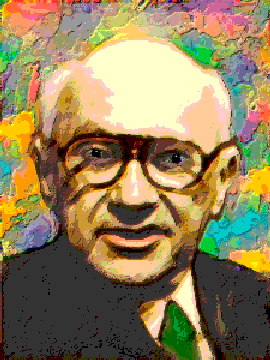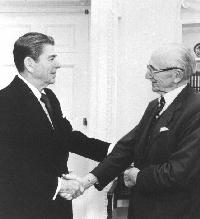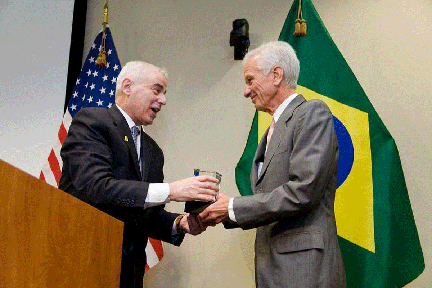The Free Market Experiment in Latin America: Assessing Past Policies and the Search for a Pathway Forward (The first of a three part series)

Beginning in the 1980s nearly all of Latin America began to take part in a great experiment, the adoption of neoliberal or capitalist free market economic policies. This policy orientation was built upon the belief that neoliberalism would bring growth, economic development, and improve the lives of most residents of the region. While the programs were not always undertaken at the same moment and were not always alike in detail and emphasis, the core principles and experiences were similar enough to allow us to pull back now and draw some general, hemispheric-level conclusions regarding the efficacy of these policies.
Neoliberalism
Neoliberalism may be generally defined as an economic theory which favors a limited role for the state in the economy. To this viewpoint, the state should act in defense of private property and contract rights, but otherwise should avoid interfering in the functioning of the economy. Neoliberalism involves cutting government spending; balancing the budget; selling off government-owned enterprises; ending government subsidies; a commitment to eliminating price controls on all commodities and services, including basic necessities; letting the market, not government action, set the minimum wage; ending restrictions on foreign ownership of domestic assets; the lowering or elimination of tariffs; and ending restrictions on foreign profit repatriation.
Neoliberalism began as an anti-mainstream body of thought, most fully articulated by Friedrich von Hayek of the Austrian School of Economics (Nobel Prize in 1974) at the 1947 founding of the Mont Pelerine Society. By the 1970s the University of Chicago’s Milton Friedman (Nobel Prize in 1976) had further articulated and then helped spread the free market vision. The philosophy gained significant political support in 1979 with the election of British Prime Minister Margaret Thatcher who was strongly influenced by Hayek. U.S. President Jimmy Carter’s 1979 appointment of Paul Volcker as head of the Federal Reserve Bank and then the 1980 election of Ronald Reagan further advanced the free market impulse. Reagan pronounced the victory of the new orthodoxy at the World Bank in 1983: “The societies that achieved the most spectacular … economic progress … [were] united … [in] their belief in the magic of the marketplace.”[1]

Ascendant politically, the neoliberal philosophy came to dominate thinking inside the international economic institutions, above all at the International Monetary Fund (IMF). Neoliberal ideology portrayed itself as the common-sense view, promoting market openness, reform, competitiveness, and rationalization. It was a technocratic clean fix; it was obvious, it was beyond ideology.[2] The “Washington Consensus” had formed: no other economic ideas need be taken all that seriously.
The IMF and its sister institution, the World Bank, fully convinced of the virtue and inevitability of free markets, turned their collective attention to advancing these policies around the world. In this undertaking the Latin American debt crisis of the 1980s supplied them considerable leverage. The 1980s brought Latin American’s worst economic downturn ever, a “lost decade.” Average annual GDP growth in Latin America slowed to 1.1 percent, compared to the prior decade (1970-1980) when the economy had grown at 5.6 percent a year. As the crisis deepened, Latin America desperately sought to arrange new loans just to pay the interest due on existing foreign obligations. IMF and World Bank loans were essential, for they signaled to large commercial banks the inherent credit-worthiness of debtor nations. However, IMF and World Bank loans were conditioned upon the adoption of the neoliberal policies. By the mid-1980s three of four Latin American nations were under IMF or World Bank supervision.[3]
Latin American adoption of neoliberal policy was more than just the product of external pressure. Many Latin American leaders were true believers in the new economic religion. Brazilian Central Bank President Gustavo Franco summed up this attitude in 1996, holding that one could be either “neo-liberal or neo-idiotic.”[4] Some of the converts had been trained in U.S. universities and others were influenced by economists imported from the United States. But whether out of authentic belief in the virtues of free markets or due to the pressure applied by the IMF and World Bank, by the mid-1980s neoliberalism policies were being cemented into place across Latin America, in many places over considerable social objections and political resistance.
Economic Growth: Import Substitution Industrialization and Neoliberalism
From the late 1940s until the late 1970s Latin American generally followed import-substitution industrialization policies (ISI) which called for the state to take the lead role in fostering industrialization and economic development. Governments provided subsidies and other financial incentives to new industries that where sprouting into existence. The ISI model was promoted by the United Nations’ Economic Council for Latin America (ECLA) (today ECLAC, Latin America and the Caribbean) as a long-term solution to the Great Depression of the 1930s. In ECLA’s view, without government action industrialization could never take root.[5]
To its many critics, however, ISI was irresponsible and unwise. To this view ISI was the product of unctuous populist political leadership, men who knew how to get elected but who understood nothing about economics. To critics, ISI inserted incompetent and often corrupt government officials into all economic matters, producing inefficient hot-house industries, and always ended in runaway inflation. Worse, critics found, ISI created a maze of government regulation, chocking off entrepreneurship, strangling economic growth, and killing the chance for long-term development.
What is lost in this critique, however, is that Latin America’s annual GDP growth rates set historic highs under ISI policies. Of course, economic growth by itself does not mean that people are necessarily better off. Growth is, however, the measure that neoliberals most prefer to look at, so it is a fair place to begin. In the years 1870 to 1913 Latin America’s GDP rose at a rate of 3.3 percent a year; from 1913 to 1950, averaging 3.4 percent a year; but from 1950 to 1980 under ISI policies Latin America’s GDP increased at 5.5 percent a year, a rate well in excess of the global average. Economic growth in Latin America under ISI or state-led development was actually much stronger than that subsequently achieved under neoliberal policies. From 1950 to 1980, the preeminent era of ISI, Latin America averaged 3.11 percent a year per capita GDP growth. In the 1980s, during the change-over to neoliberal policies, average annual per capita GDP growth actually declined 0.9 percent a year. During the 1990s, a time when neoliberal policies were in place nearly everywhere in Latin America outside of Cuba, average annual GDP per capita growth scored an anemic 1.1 percent a year. Over the past three decades, most of it spent under neoliberal polices, Latin America’s per capita GDP growth has also been slower than that in other parts of the world. In 1981, Latin America’s per capita GDP was 20 percent above the world average, but by 2006 it skidded to 11 percent below the world average.[6]
Under neoliberal policies from 1990 to 2004, Latin America’s per capita GDP rose at only 1.3 percent a year, seriously outperformed by a region which used the state to help guide development scripts to some extent, South Asia, 3.5 percent per capita annually; to a larger extent, East Asia, 6.7 percent per capita annually; or to a very great extent, China, 8.6 percent per capita year. For the years 1997 to 2007, Latin America’s per capita GDP annual growth rate ranked at the bottom of world, tied with Sub-Sahara Africa.[7]
The conventional wisdom about ISI is that while it might have produced some growth and associated benefits, it could not lead to a takeoff into sustained development. Some heavy industry emerged, it is argued, but this was only because the factories were cocooned under government protection. However, this commonly repeated viewpoint is contradicted by available evidence. Under ISI polices from 1950 to 1981, industrial output rose ten times over in Mexico and Brazil, and three times over in Argentina and Chile. For Latin America from 1939 to 1973, industry as a percentage of GDP rose from under 17 percent to over 25 percent.[8]
Critics of ISI note that economic growth slowed for Latin America in the late 1970s, proving to their minds that the ISI model had been exhausted. However, economic growth slowed in much of the world from the late 1970s to the early 1990s due to global factors, especially the oil price shocks and follow-on debt crises. Periodic economic downturns such as these area general feature of the international economy, not just a particular function of ISI.
A more sound historical assessment of ISI is that some, not all, of the practices and policies were flawed. One key difficulty with ISI as it was implemented was that under the undemocratic nature of former regimes, élite interests did much to shape its policy details, and those with good political connections effectively converted what had been intended as temporary protection of nascent industries into permanent entitlements. “The … issue,” as Henry Bruton has put it, “is then to design protection measures that induce learning rather than the easy life.”[9] For all its flaws, ISI did work. As one analist, Mark Weisbrot, has noted, if Brazil had continued to grow after 1980 at the same rate it achieved under ISI policies, then “Brazil would have European living standards today.”[10] The ISI experience cannot be said to have proven that all efforts at state-led development are ill-advised.
Debt and Inflation
Critics have held that ISI policies produced massive debts from an orgy of spending by populists leaders who pandered shamelessly to the unlettered masses.[11] But there is a far better explanation of the origin of the Latin America debt crisis. The problem began in the 1970s with the ready availability of foreign loans (“an irresistible temptation,” as economic historian Victor Bulmer-Thomas has put it).[12] What made foreign loans so easy to obtain were the financial implications of the OPEC price hikes of 1973 and 1974. Flush with funds, OPEC nations chose the safest place to park their earnings: U.S. banks. The banks took the petro-dollars and sought to turn them into assets, loaning the money out. Because Latin America looked to be a compelling place to invest, the latest go-go area, an unprecedented cascade of dollars flowed south. Nearly all Latin American states, especially those governed by the military, borrowed heavily in these years, using the money to cover current expenses, forego tax increases, or investing in white elephant projects. Sometimes the money just disappeared into corrupt hands.

The heavy borrowing and unwise spending turned out to be unsustainable. Mexico came near defaulting in 1982, and suddenly Latin America appeared to be a very unwise place to invest. New lending dried up, leaving behind vast sums to be repaid. Just paying the interest due on its foreign debt often claimed nearly half of Latin America’s export earnings in the 1980s. As economic historians Werner Baer and Joseph Love observed, “during the 1980s many Latin American countries made larger transfers as a share of GDP than the reparations payments of Germany after the First World War.”[13]
The 1980s and the early 1990s were a time of extraordinarily high inflation in Latin America, and taming inflation was a central objective, even fixation, of the neoliberal project. In Brazil the annual inflation rate crested as high as 1,862 percent (in 1989); 2,177 percent in Bolivia (1984); 4,924 percent in Argentina (1989); and as high as 7,482 percent in Perú (1990). Today’s inflation rates are in single digits figures nearly everywhere in Latin America.[14] But it was not so much the careful application of neoliberal cures as the easing of the debt crisis by the mid-1990s that underlay the decline in inflation rates. What originally had been driving hyper-inflation was the servicing of the vast foreign debt. After the U.S. Brady Plan of 1989 allowed indebted Latin American countries access to the secondary loan market, Latin American nations began to buy back some of their external obligations, steadily lowering their total foreign indebtedness. Paying less in servicing their foreign debts, they borrowed fewer dollars, thereby reducing the existing money supply. There was less money in circulation chasing the same amount of goods, and this lowered inflation.
Recent Growth Performance
The years from 2003 to 2008 brought strong economic growth for Latin America as a whole, with a combined average growth rate recording a healthy 5 percent a year compared to the world average of 3.6 percent a year. The top regional economic performers were the winners in the “commodity lottery,” where in any given year some primary product exports do particularly well in the international market.[15] Chile and Perú have done well in the commodity lottery, with increased production of copper, fruit, fish, and lumber for Asian markets. By 2008 China and Japan were purchasing a fifth of Peruvian and a quarter of Chilean exports, with raw materials making up three-quarters of shipments.[16] While this growth is good, raw material export is not a pathway to economic development. Focusing on primary product extraction serves instead to reinforce existing productive structures. Economic growth and economic development are not the same thing.[17]
The boom ended in 2008 and Latin America fell into a sharp recession until mid-2009, a downturn second in severity only to the Great Depression of the 1930s. This difficult episode, at a time when the Latin American economy was contracting by 3 percent per capital in 2009, was in many ways the result of the stripping away of government regulations, the vital safeguards meant to serve to protect Latin American economies from speculation-driven swings in the international economy.[18]
Some free market supporters argued that what explained the failing Latin American economies was that they were “non-compliant” in adopting neoliberal measures. Had these nations authentically embraced the free market philosophy then things would have gone much better. For the many obviously neoliberal states that failed to grow, defenders of the free market model seized upon any doctrinal apostasy, no matter how minor, in an effort to explain away weak domestic economic performances. In the alternative, defenders of the free market model argued that nations that failed to grow under the neoliberal regimen did not have the appropriate civil practices or institutions, lacking honest and efficient bureaucracies; respect for the rule of law; protection of private property rights, especially intellectual property rights; contract enforcement; or a sound banking structure. However, it is at least equally valid to argue that these institutions are created by the process economic development, not the foundation of it. History would seem to so suggest.[19]

Latin American economies generally recovered from mid-2009 to the present. Economies commonly post good growth numbers coming out of recessions as they make use of under-utilized capacity. The Latin American nations that came through this episode the most quickly were those that employed counter-cyclical Keynesian government spending programs designed to stimulate the economy. Ecuador, for example, greatly expanded its housing assistance and cash transfer programs to poor households.[20]
Accordingly, some conclusions regarding the performance of neoliberalism are warranted. Neoliberalism achieved poorer GDP growth records than did prior state-led development policies in Latin America. Latin America under neoliberalism did worse in GDP growth than did other developing areas that used the government to guide or assist in the development process. State-led development policies achieved a much stronger record of success in Latin America than did free market policies.
Note: Part Two will explore the social costs of the neoliberal project and the factors that led to widespread abandonment of the experiment with free-market economic policies in Latin America.
Dr. Ronn Pineo, Senior Research Fellow at the Council on Hemispheric Affairs, and Professor and Chair of the Department of History at Towson University
Please accept this article as a free contribution from COHA, but if re-posting, please afford authorial and institutional attribution. Exclusive rights can be negotiated.
For additional news or analysis on Latin America, please go to: Latin News
_____________________________
References
[1] Quoted in, Peet, Richard. Unholy Trinity: The IMF, World Bank and WTO. Zed Books, 2009, 14.
[2] Birdsall, Nancy, et al. “The Washington Consensus: Assessing, a ‘Damaged Brand,’” in José Antonio Ocampo and Jaime Ros, editors, The Oxford Handbook of Latin American Economics. Oxford University Press, 2011, 82; Ardanaz, Martín, et al. “Political Institutions, Policymaking, and Economic Policy in Latin America,” in Oxford Handbook, 54; Weisbrot, Mark, et al. “The Emperor Has No Growth: Declining Economic Growth Rates in the Era of Globalization.” Center for Economic Policy Research, November 27, 2000, 5; and Nef, Jorge and Robles, Wilder. “Globalization, Neoliberalism, and the State of Underdevelopment in the New Periphery.” Journal of Developing Societies 16:1 (April 2000): 28-31.
[3] Ocampo, José Antonio and Ros, Jaime. “Shifting Paradigms in Latin America’s Economic Development,” in Oxford Handbook, 15-16.
[4] Quoted in, Palma, José Gabriel. “Why Has Productivity Growth Stagnated in Most Latin American Countries Since the Neo-Liberal Reforms?” in Oxford Handbook, 568.
[5] Ocampo and Ros. “Shifting Paradirms, 3; Kay, Cristóbal, and Gwynne Robert N. “Relevance of Structuralist and Dependency Theories in the Neoliberal Period: A Latin American Perspective.” Journal of Developing Societies 16:1 (April 2000): 49-70.
[6] Ardanaz, et al, “Political Institutions,” 53; Birdsall, et al, “The Washington Consensus,” 90-91; Luiz Carlos Bresser-Pereira, “From Old to New Developmentalism in Latin America,” in Oxford Handbook, 111-112; Cimoli, Mario and Porcile, Gabriel. “Learning, Technological Capabilities, and Structural Dynamics,” in Oxford Handbook, 551; Bacha, Edmar L. and Fishlow, Albert. “The Recent Commodity Price Boom and Latin American Growth: More Than New Bottles for an Old Wine?” in Oxford Handbook, 403; Palma, “Productivity Growth,” 5671; Stallings, Barbara and Peres, Wilson. “Is Economic Reform Dead in Latin America? Rhetoric and Reality Since 2000.” Journal of Latin American Studies 43 (2011), 757, 761-762; Ros, Jaime. “Poverty Reduction in Latin America: The Role of Demographic, Social, and Economic Factors.” CEPAL Review 98 (August 2009), 38; Moreno-Brid, Juan Carlos and Ros, Jaime. Development and Growth in the Mexican Economy. Oxford University Press, 2009, 7, 10; Ocampo, José Antonio. “Latin America’s Growth and Equity Frustrations During Structural Reforms.” Journal of Economic Perspectives 18:2 (Spring 2004), 67, 68, 70; and Franko, Patrice. The Puzzle of Latin American Development. Rowman& Littlefield, 2003), 65, 131, 134, 137, 139.
[7] Hausmann, Ricardo. “Structural Transformation and Economic Growth in Latin America,” in Oxford Handbook, 521; Ocampo and Ros, “Shifting Paradigms,” 20; Palma, “Productivity Growth,” 568, 602; Abeyta, Jacob. “Trade’s Trade Offs.” Council on Hemispheric Affairs (October 20, 2008); and Bruton, Henry. “A Reconsideration of Import Substitution.” Journal of Economic Literature 36:2 (1998): 924-925.
[8] Ocampo and Ros, “Shifting Paradigms,” 13; Tussie, Diana. “Latin America in the World Trade System,” in Oxford Handbook, 318-319; and Ocampo, “Latin America’s Growth,” 76; Kay and Gwynne, “Relevance,” 54.
[9] Bruton, “Reconsideration,” 930-931.
[10] Weisbrot. Mark. “Who Will Allow Brazil to Reach Its Economic Potential?” Monthly Review on-line. October 29, 2010.
[11] Ardanaz, et al. “Political Institutions,” 53; Birdsall, et al. “The Washington Consensus,” 80, 82; and Bresser-Pereira. “From Old to New Developmentalism,” 111.
[12] Bulmer-Thomas, Victor. The Economic History of Latin America Since Independence. Cambridge University Press, 1994, 427.
[13] Baer, Werner and Joseph L. Love. “The Roots of Latin America’s Backwardness,” in Derek H. Aldcroft and Ross E. Catterall, editors, Rich Nations—Poor Nations: The Long-Run Perspective. Edward Elgar, 1996, 55.
[14] Birdsall, et al. “The Washington Consensus,” 85; and United Nations. Economic Commission for Latin America and the Caribbean. Economic Survey of Latin America and the Caribbean, 2009-2010. ECLC, 2010, 21.
[15] Lora, Eduardo. “The Effects of Trade Liberalization on Growth, Employment, and Wages,” in Oxford Handbook, 368; Stallings and Peres, “Economic Reform,” 761-762; Santiso, Javier and Zoido, Pablo. “Fiscal Legitimacy, Inequalities, and Democratic Consolidation in Latin America,” in Oxford Handbook, 293; and Bárenca, Alicia. “Structural Constraints on Development in Latin America and the Caribbean: A Post Crisis Reflection,” CEPAL Review 100 (April 2010): 9-10.
[16] United Nations. Economic Commission for Latin America and the Caribbean. Latin American Economic Outlook 2012: Transforming the State for Development. ECLAC, 2012, 7; Gallagher, Kevin P. and Porzecanski, Roberto. “China and the Future of Latin American Economic Development,” in Oxford Handbook, 465, 467, 484; Cimoli and Porcile, “Technological Capabilities,” 552; United Nations. Economic Survey, 2009-2010, 33; and Weintraub, Sidney. “An Economic Storm Hits Latin America,” Current History (February 2009): 59.
[17] Pineda, José Gregorio and Rodríguez, Francisco. “Curse or Blessing? Natural Resources and Human Development,” in Oxford Handbook, 414-415; Miguel, Carlos J. de and Sunkel, Osvaldo “Environmental Sustainability,” in Oxford Handbook, 131; Bacha and Fishlow, “ Recent Commodity Price Boom,” 398; “It’s Only Natural: Commodities Alone are Not Enough to Sustain Flourishing Economies,” The Economist 396:8699 (September 11, 2010); and Abeyta, “Trade’s Trade Offs.”
[18] Ffrench-Davis, Ricardo and Griffith-Jones, Stephany. “Taming Capital Account Shocks: Managing Booms and Busts,” in Oxford Handbook, 161; and United Nations. Economic Survey, 2009-2010, 7,18.
[19] Bértola, Luis. “Institutions and the Historical Roots of Latin American Divergence,” in Oxford Handbook; Chang, Ha-Joon. 23 Things They Don’t Tell You About Capitalism. Bloomsbury Press, 2010; Starr, Pamela. “The Political Economy of Reform in Latin America: Politics, Institutions, Ideas, and Context.” Latin American Research Review 44:3 (2009): 224-234; Chang, Ha-Joon. Bad Samaritans: The Myth of Free Trade and the Secret History of Capitalism. Bloomsbury Press, 2008; and Chang, Ha-Joon. Kicking Away the Ladder: Development Strategy in Historical Perspective. Anthem Press, 2005.
[20] Markwick, Sandy. “Peru: Economy,” Europa World Plus. 2013; Ray, Rebecca and Kozamen, Sara. “Ecuador’s Economy Since 2007,” Center for Economic and Policy Research (May 2012), 1; Birdsall, et al, “The Washington Consensus,” 93; Stallings and Peres, “Economic Reform,” 761-762; Cárdenas, Mauricio and Perry, Guillermo. “Fiscal Policy in Latin America,” in Oxford Handbook, 267; Chang, Ha-Joon. 23 Things, 247-248; United Nations. Economic Survey, 2009-2010, 19.

